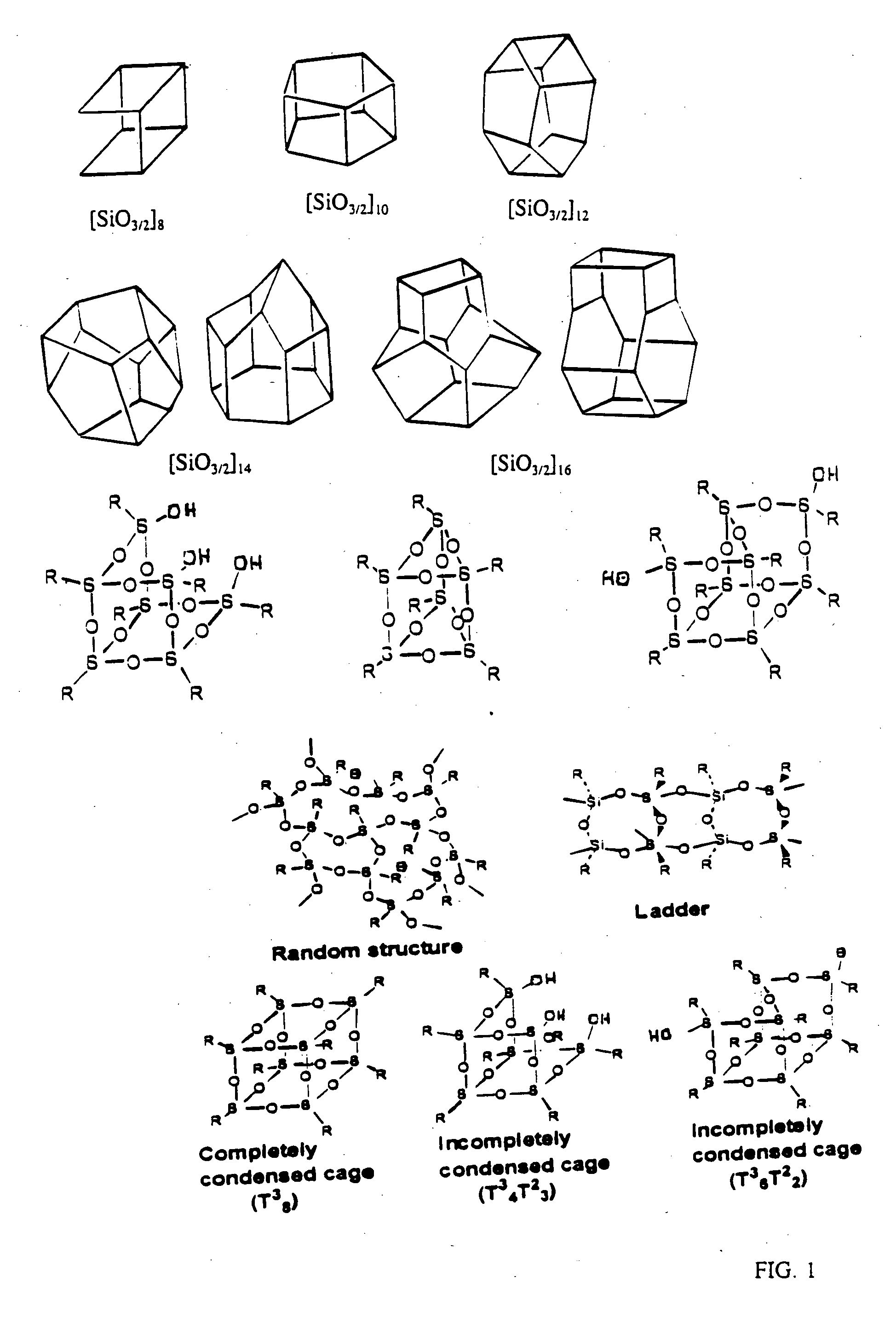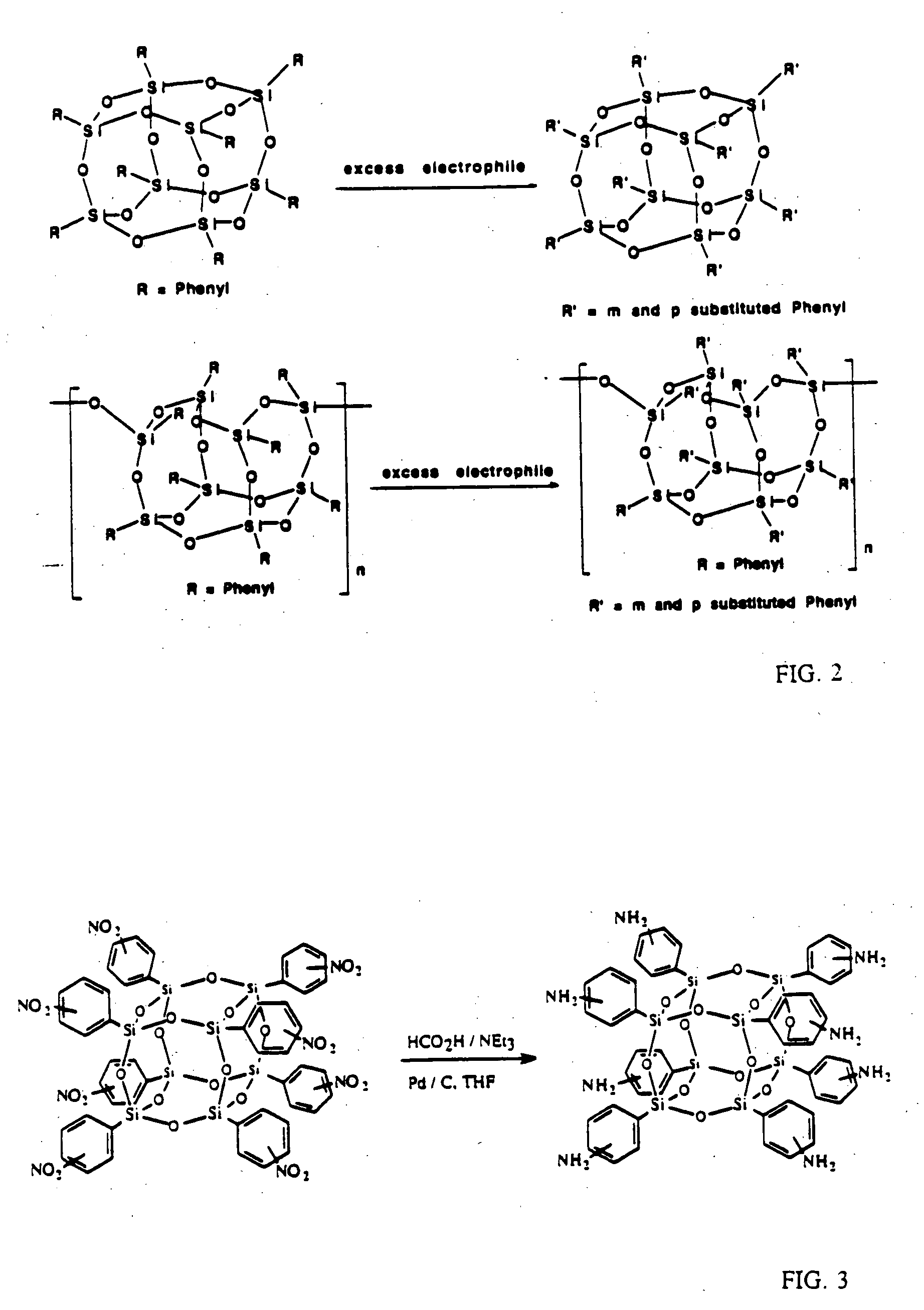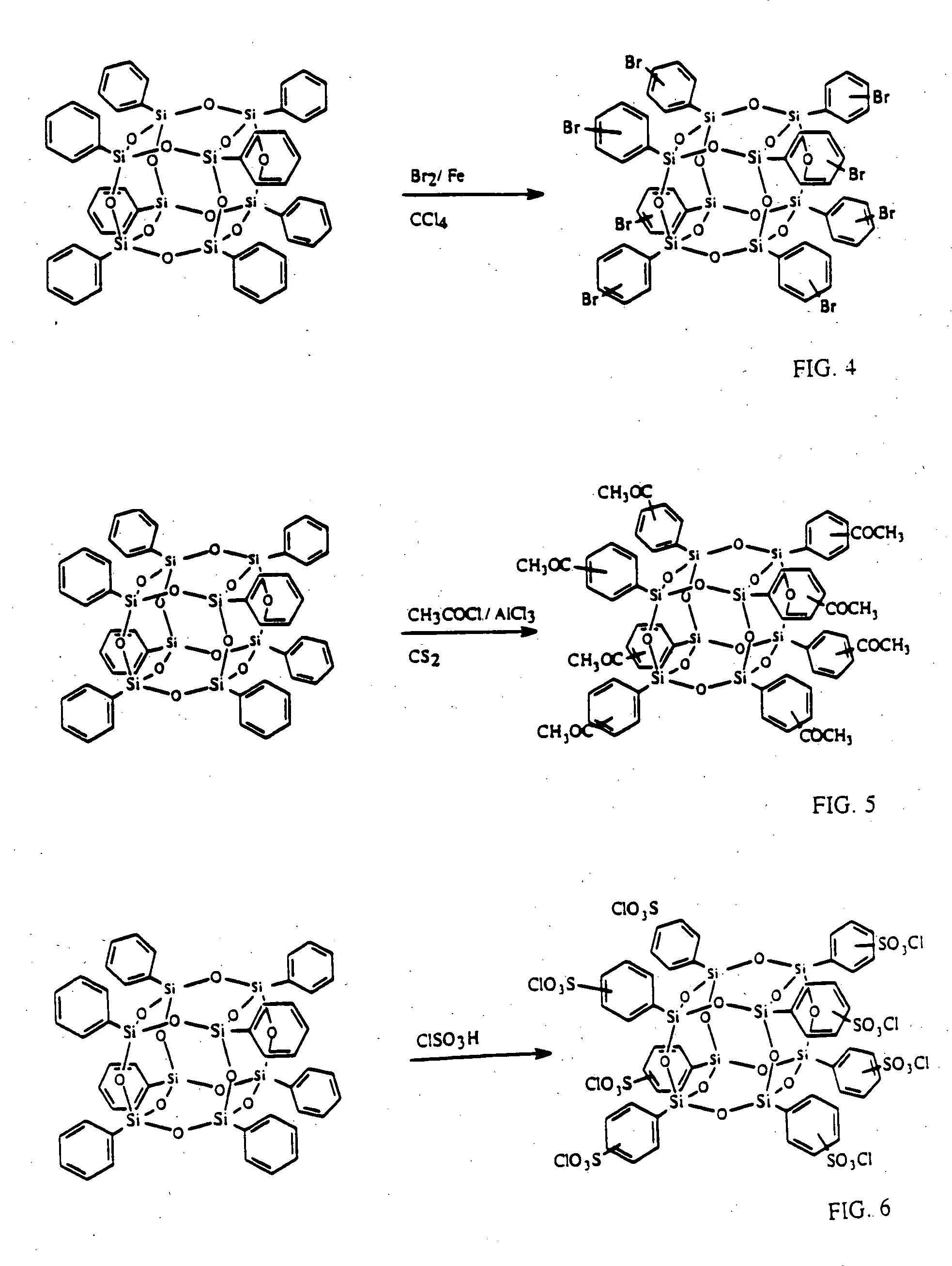Well-defined nanosized building blocks for organic/inorganic nanocomposites
a nano-building block and organic/inorganic nano-composit technology, applied in the field of functionalized, discrete silsesquioxanes, can solve the problems of inability to prepare nano-composites with well-defined nanostructural units from such products, limited functionality of such silica, irregular size and geometry of individual particles,
- Summary
- Abstract
- Description
- Claims
- Application Information
AI Technical Summary
Benefits of technology
Problems solved by technology
Method used
Image
Examples
example 1
Synthesis of Octa(nitrophenyl)silsesquioxane (ONPS)
[0070] To 30 ml of fuming nitric acid was added with stirring and cooling in ice water 5.0 g (4.8 mmol) of OPS in small portion. After all has been added, the solution was stirred at 0° C. for 30 min and further stirred at room temperature for another 20 h. The solution was then poured on 250 g of ice. When the ice has melted, a very faintly yellow precipitate was collected, washed with water and then with acetonitrile. The obtained powder was dried in a vacuum oven to remove residual solvent (70° C. for 4 h). Weight 3.0 g (2.2 mmol, recovery 46%). Chemical analysis, thermal and spectral data are listed below.
[0071] Octanitrophenylsilsesquioxane
Octanitrophenylsilsesquioxane1H-NMR(acetone-d6):8.7(t, 1.0H), 8.4-8.0(m, 4.1H), 7.8(m, 2.7H)13C-NMR(acetone-d6):154.0, 148.9, 141.0, 138.6, 136.5, 135.3,134.1, 132.3, 130.8, 129.5, 127.0, 125.2,123.629Si-NMR(THF, TMS,−79.2, −83.0acetone-d6, ppm):FT-IR(cm−1):3090(δC—H), 1533, 1350(δN═O),11...
example 2
Synthesis of Octa(acetylphenyl)silsesquioxane (OAcPS)
[0072] Into a 50 ml of schlenk flask was placed 0.522 g (3.92 mmol) of aluminum chloride with 5 ml of CS2. The mixture was stirred at 0° C. under nitrogen for 15 min. OPS (0.5 g, 0.484 mmol, -Ph 3.87 mmol) was then added to the mixture with stirring and the suspension was stirred at 0° C. for 30 min and 20 h at room temperature. To quench the reaction, 5 g of ice was added and the organic layer was extracted with 10 ml of methylene chloride. The organic layer was washed with water until the aqueous layer became pH=˜7 and dried over sodium sulfate. Undissolved powder was removed from the methylene chloride solution by filtration and the obtained clear solution was added dropwise into 50 ml of hexane, which gave white powder. The powder was collected by filtration and washed with hexane. Yield was 0.319 g (60.1%) (assuming the conversion of the phenyl group to the acetylphenyl group was 66.9%. Analytical data are in Table 1.
[0073]...
example 3
Synthesis of Octa(acetylphenyl)silsesquioxane (OAcPS)
[0074] The same reaction conditions as in Example 2 were used except the reaction temperature. After mixing all the reagents, the mixture was refluxed under nitrogen for 1 h and ethyl acetate was used for the extraction instead of methylene chloride. Yield was 0.44 g (76%). Analytical data are in Table 1.
[0075] Octaacetylphenylsilsesquioxane
1H-NMR(CDCl3):8.3(m, 1.0H), 8.0(m, 1.9H), 7.5(m, 1.1H),2.5(m, 3.0H)13C-NMR(CDCl3):198.2, 138.6, 136.6, 134.0, 131.1, 129.7,128.5, 26.529Si-NMR(THF, TMS,−80.0acetone-db, ppm):FT-IR(cm−1):3320(broad, δO—H), 3060(δC—H),1690(δC═O), 1593, 1417, 1360(δC═C),1139(δSi—O)TGA(air / wt % / 1000° C.):42.3(cal. 35.1)TGA(N2 / wt % / 1000° C.):—Elemental Analysis:% C: 49.4(56.1) % H: 4.0(4.1) % N: —GPC:Mn=1006, Mw=1060, Mw / Mn=1.05
PUM
| Property | Measurement | Unit |
|---|---|---|
| size | aaaaa | aaaaa |
| thickness | aaaaa | aaaaa |
| temperature | aaaaa | aaaaa |
Abstract
Description
Claims
Application Information
 Login to View More
Login to View More - R&D
- Intellectual Property
- Life Sciences
- Materials
- Tech Scout
- Unparalleled Data Quality
- Higher Quality Content
- 60% Fewer Hallucinations
Browse by: Latest US Patents, China's latest patents, Technical Efficacy Thesaurus, Application Domain, Technology Topic, Popular Technical Reports.
© 2025 PatSnap. All rights reserved.Legal|Privacy policy|Modern Slavery Act Transparency Statement|Sitemap|About US| Contact US: help@patsnap.com



